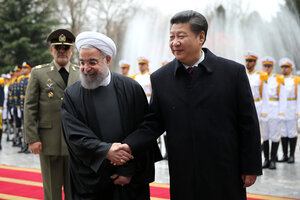Why is China trying to revive ancient Silk Road?
The Silk Road is part of China’s 'One Belt, One Road,' an economic development strategy launched by Chinese president Xi Jinping in 2013.

Chinese President Xi Jinping, right, shakes hands with Iranian President Hassan Rouhani in an official arrival ceremony, at the Saadabad Palace in Tehran, Iran.
Ebrahim Noroozi/AP/File
The first cargo train from China to Iran arrived in Tehran on Monday, marking a milestone in reviving the ancient Silk Road trade route.
The 32-container train passed through Kazakhstan and Turkmenistan to Iran, taking 14 days (30 days less than a typical sea voyage between Shanghai and the Iranian port of Bandar Abbas) to complete the 6,462 mile journey from China’s eastern city of Wiyu.
The Silk Road – envisioned as a rail and sea route – is part of China’s “One Belt, One Road,” an economic development strategy, which has opened a new chapter of win-win cooperation between China and Iran, Xinhua reported.
“Countries along the Silk Road are striving to revive the ancient network of trade routes,” said Mohsen Pour Seyed Aghaei, president of the Islamic Republic of Iran Railways company, according to the Guardian. “The arrival in Tehran of the train in less than a fortnight has been an unprecedented achievement.”
"To revive the Silk Road Economic Belt, the launch of the train is an important move, since about 700 kms of trip has been done per day," he added.
The train will leave every month and the frequency will be increased if necessary, Iranian officials said.
The train arrived a few weeks after Chinese president Xi Jinping visited Iran, becoming the first global leader to do so since economic sanctions were lifted.
The $40 billion "One Belt, One Road" initiative – or simply the "Belt and Road" – is an initiative launched by Chinese President Xi Jinping in 2013. The project seeks to promote “common development, connectivity and co-operation, and it consists of two main components: the land-based Silk Road Economic Belt (SREB), which focuses on linking China with Europe through Central and Western Asia; and the 21st Century Maritime Silk Road (MSR), which is designed to connect China with Southeast Asian countries, Africa, and Europe,” according to Euroasia Industry.
Amid criticism that its multi-billion dollar Silk Road initiative to revive ancient trade routes is a "geopolitical tool" aimed at extending influence, Beijing responded by dismissing the claims. The New York Times had written an article saying that Beijing's push to revive the ancient trade routes is causing geopolitical strains, with countries increasingly worried about becoming too dependent on China. Beijing’s Foreign Ministry spokesperson Lu Kang responded to the article by saying the "Belt and Road" is an open and inclusive initiative for regional cooperation and not a geopolitical tool, The Economic Times reported.
Since Mr. Xi announced the plan in his 2013 visit to Kazakhstan, Eurosia Industry reports, it has mushroomed into a significant policy and the centerpiece of the president’s international economic strategy.
While most analysts agree that the initiative will expand economic activities for nearby countries spread along the traditional Silk Road, some are unsure about the feasibility of the plan, pointing to the political unrest and insurgency in areas along the route of the Belt and Road, including China’s autonomous Xinjiang Uighur region (XUAR) – the emerging core zone of the Silk Road Economic Belt.
According to the Global Perspectives Magazine for International Cooperation, separatist groups in Xinjiang, such as the Uighurs’ East Turkistan Islamic Movement (ETIM) have forged links with militants and extremists in Pakistan, Afghanistan, and the Central Asian republics.
Analyst attribute the Xinjiang unrests to the economic divide between the Han-majority northern city of Urumqi and Uighur. As the Guardian reported, many “Uighurs feel like second-class citizens in Xinjiang, culturally, socially and economically discriminated against by the now-dominant Han."
Yet the plan could be the path to long-term stability for Xinjiang. A Chinese official was quoted saying that “Xinjiang will be the biggest beneficiary of the Silk Road,” and “will help it open up further, increase trade, tourism and other exchanges with neighboring countries,” according to the Guardian.
The Silk Road dates back to 220 BC, and was named after the lucrative Chinese silk trade that were central to business across the Asian continent, connecting China to the Mediterranean Sea. It was a significant player in the rise of both Eastern and Western civilizations, including China, India, Greece, Rome, and Persia.

